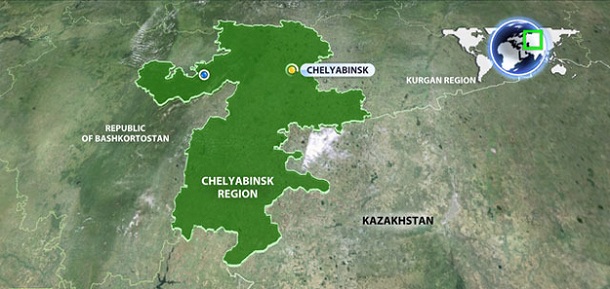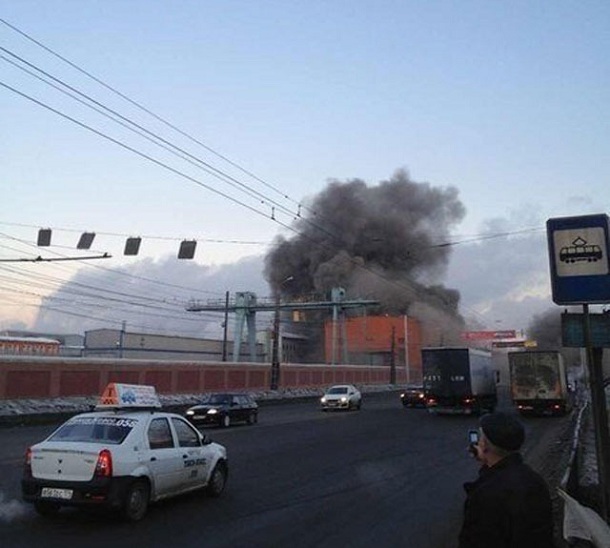
More than 500 people have been injured after a meteor strike in central Russia Ural area , the country’s interior ministry said.
Fragments of at least one meteorite were seen falling from the morning sky in the Chelyabinsk region at around 9am local time, around 1,500km east of Moscow.
Witnesses described feeling a pressure wave and hearing explosions overhead as the object hurtled to earth. Windows shattered and there were localised power cuts, sparking panic among residents.
According to unconfirmed reports, the meteorite was intercepted by an air defense unit at the Urzhumka settlement near Chelyabinsk. A missile salvo blew the meteorite to pieces at an altitude of 20 kilometers, local newspaper Znak reports quoting a source in the military.
Regnum news agency quoted a military source who claimed that the vapor condensation trail of the meteorite speaks to the fact that the meteorite was intercepted by air defenses.
Army units found three meteorite debris impact sites, two of which are in an area near Chebarkul Lake, west of Chelyabinsk. The third site was found some 80 kilometers further to the northwest, near the town of Zlatoust. One of the fragments that struck near Chebarkul left a crater six meters in diameter.
Russian space agency Roskosmos has confirmed the object that crashed in the Chelyabinsk region is a meteorite:“According to preliminary estimates, this space object is of non-technogenic origin and qualifies as a meteorite. It was moving at a low trajectory with a speed of about 30 km/s.”
According to estimates by the Russian Academy of Sciences, the space object weighed about 10 tons before entering Earth’s atmosphere.
As of 15:00 Moscow time, 725 people have sought medical attention in Chelyabinsk alone because of the disaster, 112 of whom have been hospitalized .Among the injured there are 84 children, Emergency ministry reported.
A bright flash was seen in the Chelyabinsk, Tyumen and Sverdlovsk regions, Russia’s Republic of Bashkiria and in northern Kazakhstan.
The Russian army has joined the rescue operation. Army units are searching for meteorite debris in several places in Chelyabinsk region and in the neighboring Tyumen region.
Radiation, chemical and biological protection units have been put on high alert. Since the explosion occurred several kilometers above the Earth, a large ground area must be thoroughly checked for radiation and other threats.
The emergencies ministry said that 20,000 rescue workers had been dispatched to help the injured and locate those needing help.
The defence ministry said it had sent soldiers to the sites of impact.
Police urged people to remain calm and asked those who had been injured to call a special hotline.
Russia’s Ministry of Interior said more than 500 people had reported injuries, with most requiring treatment for minor cuts and bruises caused by broken glass and damage to buildings. No serious injuries have been reported.
The local office of the National Emergencies Ministry said in a statement: “A meteorite disintegrated above the Urals (mountain range in central Russia), partially burning up in the lower atmosphere.
“Fragments of the meteorite reached Earth, falling in sparsely populated areas in the Chelyabinsk region.”
Many drivers in Russia have video recorders fitted in their cars in case of accidents or disputes with traffic police. Footage from these uploaded to YouTube show the fireball crashing to the ground.
There were reports of traffic in the Urals city of Chelyabinsk grinding to a halt and people seeking shelter in buildings as the fireballs lit up the sky.
The emergencies ministry confirmed the mobile phone network was temporarily cut.
Schools have been closed for the day across the region after the impact blew out windows.
The Chelyabinsk region is Russia’s industrial heartland, home to many factories and other huge facilities that include a nuclear power plant and the Mayak atomic waste storage and treatment centre.
A spokesman for Rosatom, the Russian nuclear energy state corporation, said that its operations remained unaffected.
“All Rosatom enterprises located in the Urals region – including the Mayak complex – are working as normal,” said a Rosatom spokesman.



